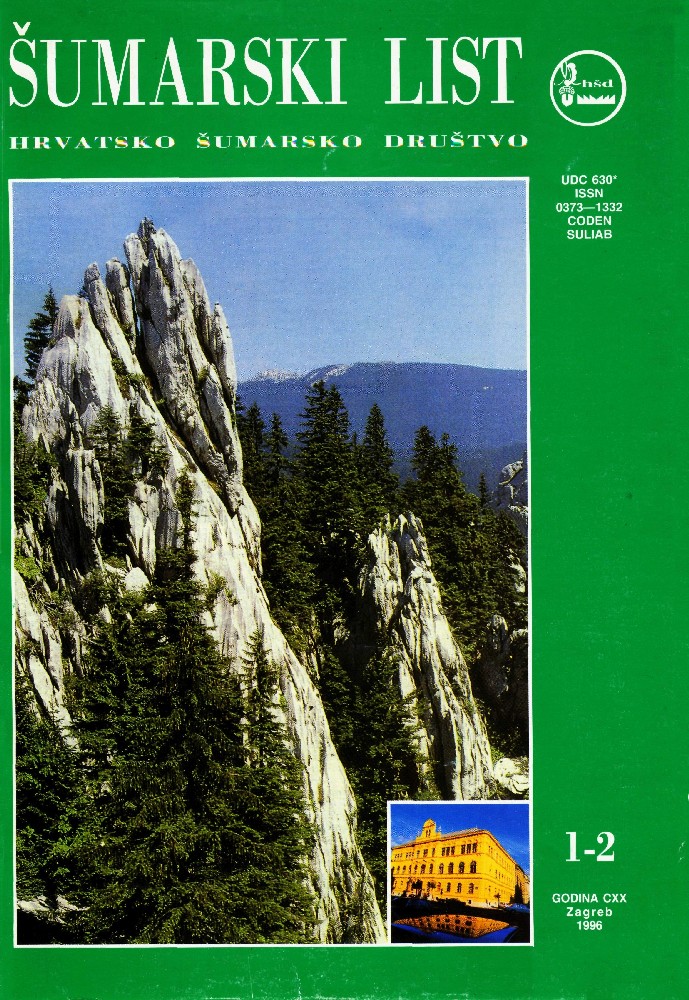
broj: 1-2/1996
pdf (19,4 MB) |
|
||||||||||||||
| IZVORNI ZNANSTVENI ČLANCI | ||
| Trinajstić, I. | UDK 630* 43+231.001 | |
| Succession of the Vegetation on Placea of Burned Holm oak and Black ash ass. Orno-Quercetum ilicis Forests in Croatia pdf HR EN | 3 | |
| Figurić, M. | UDK 630* 906.001 | |
| A Discussion on the Concept of Sustainable Management Influencing the Assessment of Forest Resource Value pdf HR EN | 9 | |
| PREGLEDNI ČLANCI | ||
| Tomašević, A. | UDK 630*421 | |
| Shelterbelts in the Sinj Plain pdf HR EN | 19 | |
| Summary: Shelterbelts in the Republic of Croatia do not adequately respond to the task of protecting soil from aeolian erosion. It is an established fact that shelterbelts play a very important role in agriculture because they prevent fertile soil erosion and simultaneously increase yield per surface unit. According to the experience in the world, windbreaks take up an area ranging from 1.5 to 8 of productive soil surface, depending on the width of the main and side belts. These areas are not insignificant; however, compared to yield increase, they are manyfoldly profitable. Windbreaks are particularly useful in arid areas where yield is 4—5 times higher in dry years with strong wind. In mediocre years yields are doubled, while in very favourable years yields tend to increase by up to 15—20 times! Among other benefits provided by windbreaks, this is yet another which justifies the need of paying more attention to windbreaks in our country, too. The establishment of windbreaks in the Sinj Plain began in 1951 and lasted until 1971. The Canadian poplar, clone 1214 fpopulus x euroamericana, Dode, cv. 1-214), was used for this purpose but it didn´t prove an adequate choice. As this specie is now dying out, the need has arisen to renovate the windbreaks. The major project "SHELTERBELTS IN THE SINJ PLAIN" aimed at meeting this need was drawn up at the Agricultural Faculty of the University in Zagreb in 1989. The species envisaged by this project are: Cupressus arizonica Green., Cupressus sepervirens L. and Pinus nigra Arn. var. austriaca. Since financial means to carry out the complete project are lacking at the moment, the public company "CETINA" from Sinj has axxepted the proposal by the author of this paper to start with experimental planting of potential tree species of autochthonous and allochthonous coniferaes and brodleaves, presumed to have successful growth in the conditions prevailing in the Sinj Plain. Table 9 presents a list of potential species which are already being used or will be used for experimental planting in subsequent seasons. Understandably, no evaluation can be made as yet of the success or failure of the planted species since the experiment has only just began. Rhe first results of the experiment will be published in one of the following years. In this typically karst region, where soil is almost invisible from the stone, the Sinj Plain represents an oasis for agricultural production. The Plain covers an area of 6,190 ha, and is situated in the valley among the Dinaric mountains, at an altitude of 294—300 m. The distance from the sea is only some thirty kilometres as the crow flies. Integral land-improvement procedures undertaken in the Sinj Plain would yield large fertile procedures undertaken in the Sinj Plain would yield large fertile areas. This resource, this natural wealth should be put to its full use. | ||
| Rauš, Đ., Đuričić, I. | UDK 630*19:945.3 | |
| Educational Footpath on Kalnik pdf HR EN | 35 | |
| Jurković, M., Jurković-Bevilacqua, B. | UDK 630*232.322.5.(497.13) | |
| Mammoth tree - Sequoiadendron giganteum (Lindl.) Buchh. in Parks of Zagreb pdf HR EN | 47 | |
| Vondra, V., Blaszev, Z. | UDK 630*+90 | |
| Resystematization in Hungarian Forestry After the 1990. Social Changes pdf HR EN | 55 | |


